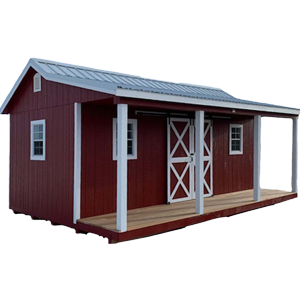Boost Your Greenhouse Garden With Companion Planting Techniques
by Dakota Storage Buildings, on March 10, 2025

Greenhouse gardening gives you endless possibilities for growing vibrant crops, but pesky pests, lackluster pollination, and wasted space can still get in the way. That is where companion planting comes in.
Companion planting is a time-tested gardening technique that pairs plants strategically to boost growth, naturally fend off pests, and make the most of every inch of your greenhouse. It is the smart, sustainable way to take your garden to the next level!
In a greenhouse, space is often limited, so companion planting can significantly help you improve yields and create a balanced ecosystem. Let’s dive into the basic principles of companion planting, effective pairings, and practical tips for optimizing your greenhouse layout.
The Basics of Companion Planting
Vegetable companion planting is all about helping your plants work together to thrive. In a greenhouse, where every bit of space and resource counts, understanding how plants support each other can make a huge difference.

By pairing plants with complementary needs, you can create a natural, balanced ecosystem that boosts growth, keeps your crops healthier, and cuts down on the need for extra pesticides or fertilizers.
How Companion Planting Works
Companion planting focuses on pairing plants together that help each other grow strong and healthy. It is a technique with roots in indigenous farming practices, inspired by how plants naturally interact and support one another. Some plants repel unwanted pests that might harm their neighbors, while others improve soil health by adding nutrients or fixing nitrogen.
But it doesn’t stop there—companion planting offers so much more. Some plants can double as natural trellises, attract pollinators, or even boost the flavor of nearby crops.
Take basil and tomatoes, for example: basil keeps pests away while enhancing the tomatoes’ taste. It is these kinds of partnerships that make vegetable companion planting such a game-changer for any greenhouse gardener.
5 Principles of Companion Planting You Shouldn’t Ignore
1. Complementary Growth Habits
Pairing plants with different growth patterns lets you optimize vertical and horizontal space in a greenhouse.
Tall plants like corn can provide shade for leafy greens or herbs that prefer partial sunlight, while sprawling plants like squash can serve as ground cover, suppressing weeds and retaining soil moisture.
2. Nutrient Needs
Grouping plants with similar nutrient requirements prevents competition and ensures healthier growth.
For example, pairing heavy feeders like tomatoes with nitrogen-fixing legumes like beans helps maintain soil balance and reduces the need for fertilizers.
3. Avoid Negative Pairings
Some plants release allelopathic chemicals that inhibit the growth of others, or they may compete for water, light, or nutrients.
For instance, fennel is notorious for stunting the growth of nearby crops, so it is best grown alone. Always research compatibility before pairing plants to avoid these conflicts.
4. Support Pest Management
Incorporate pest-repellent plants like marigolds or garlic alongside susceptible crops. These natural deterrents reduce the need for chemical interventions, creating a safer environment for both plants and gardeners.
5. Encourage Pollination
Planting flowers like nasturtiums or lavender near fruiting crops attracts pollinators to help increase yields and ensure robust growth.
By understanding and applying these principles, you can create a thriving greenhouse garden where every plant contributes to the success of its neighbors.
The Best and Worst Plant Pairings for Your Greenhouse
Pairing plants strategically can transform your greenhouse into a thriving, balanced ecosystem. By leveraging the natural benefits of specific plant combinations, you can create an environment where crops flourish, pests are minimized, and space is used efficiently. Let’s look at some good and bad companion planting examples.
Perfect Plant Pairings for Success

Tomatoes and Basil
Basil repels pests like aphids, whiteflies, and spider mites and enhances tomato growth by improving its flavor profile. Additionally, basil’s strong scent can reduce pest attraction by masking the smell of tomatoes.
Lettuce and Carrots
Lettuce acts as a living mulch, shading the soil to retain moisture and keep it cool, which is beneficial for carrots. In turn, carrots grow deep in the soil, minimizing surface-level competition for nutrients and space.
Marigolds and Vegetables
Marigolds are a powerhouse companion plant. Their roots release a natural compound that repels nematodes, while their flowers deter aphids, whiteflies, and other pests. Plant marigolds alongside crops like tomatoes, peppers, and squash to enhance protection.
Corn, Beans, and Squash (The Three Sisters)
This trio is a perfect example of plants working together. The corn acts as a trellis for the beans to climb, the beans add nitrogen to the soil to nourish all three, and the squash spreads out to shade the ground, keeping weeds in check and locking in moisture.
Avoid These Plant Pairing Mistakes

Beans and Onions
Onions release natural compounds that can hinder the growth of beans. This chemical interference prevents beans from thriving when planted too close.
Fennel and Most Plants
Fennel produces allelopathic chemicals that inhibit the growth of neighboring plants. This means that it works best as a standalone crop. Its compounds can stunt or damage the development of other plants.
Cabbage and Strawberries
These two compete for similar nutrients, and strawberries may attract pests that target cabbage, creating a problematic environment for both.
Potatoes and Tomatoes
Both are members of the nightshade family and are susceptible to similar pests and diseases. Planting them together can increase the risk of blight and pest infestations spreading between the two.
By understanding these plant pairings—both good and bad—you can create a greenhouse environment that maximizes plant health, reduces pest issues, and ensures a thriving ecosystem.
How Companion Planting Protects and Pollinates Your Crops
Companion planting not only enhances plant growth but also creates a natural defense system and attracts pollinators, ensuring healthier crops.
Naturally Keep Pests at Bay
One of the most significant benefits of vegetable companion planting is reduced reliance on chemical pesticides. Certain plants, like garlic, deter pests naturally. For example, planting garlic near roses keeps aphids at bay, while marigolds repel nematodes and whiteflies.

Attract Pollinators and Watch Your Garden Thrive
Pollination is essential for many greenhouse crops, and companion planting can attract pollinators like bees and butterflies. Flowers like nasturtiums and zinnias bring pollinators into the greenhouse, increasing your yields. Incorporating these plants enhances productivity while adding beauty to your space.
Effortless Greenhouse Gardening Starts With a Great Layout
A well-thought-out layout is crucial to maximize the benefits of companion planting in a greenhouse.
Make the Most of Every Inch
Use plants’ growth habits to your advantage.
- Pair tall plants with sprawling or vining crops to make efficient use of vertical and horizontal space.
- Trellises and hanging baskets can also help you grow more in a smaller area.
- Raised beds make it easier to group compatible plants, ensuring they thrive together.
Tailored Plant Care Through Zoning
Group plants with similar care needs, such as moisture or light requirements, into designated zones. For example, place water-loving plants like cucumbers near misters and keep drought-tolerant herbs like rosemary in a drier area. Rotating plant pairings seasonally can prevent soil depletion and maintain long-term health.
Transform Your Greenhouse With Companion Planting
Companion planting is a game-changer for greenhouse gardeners. It promotes pest control, boosts pollination, and makes the most of limited space, all while fostering a healthier environment for your crops. By understanding plant interactions and planning a thoughtful layout, you can transform your greenhouse into a thriving garden.
Ready to take your greenhouse gardening to the next level? Experiment with companion planting strategies and experience the benefits firsthand. Invest in a Dakota greenhouse today to create the perfect space for your plants and your gardening vision.

























